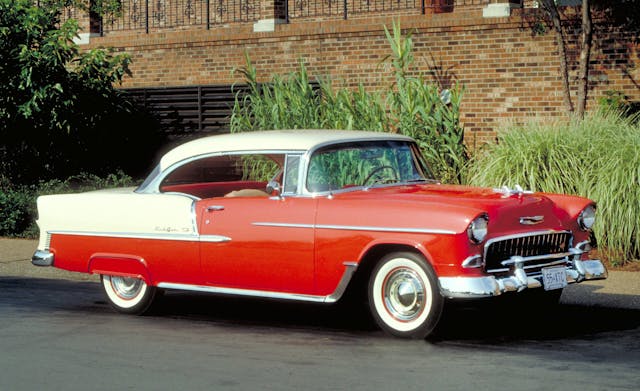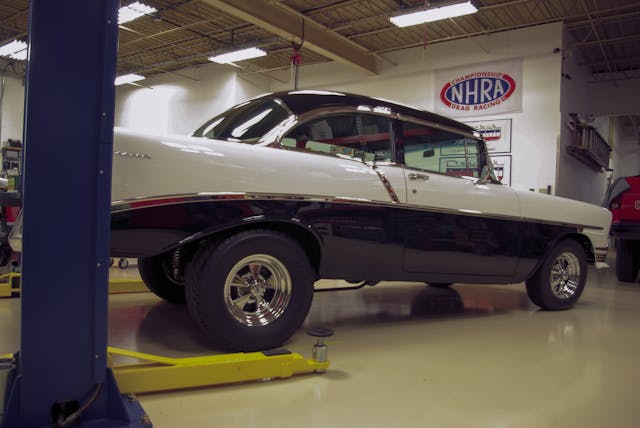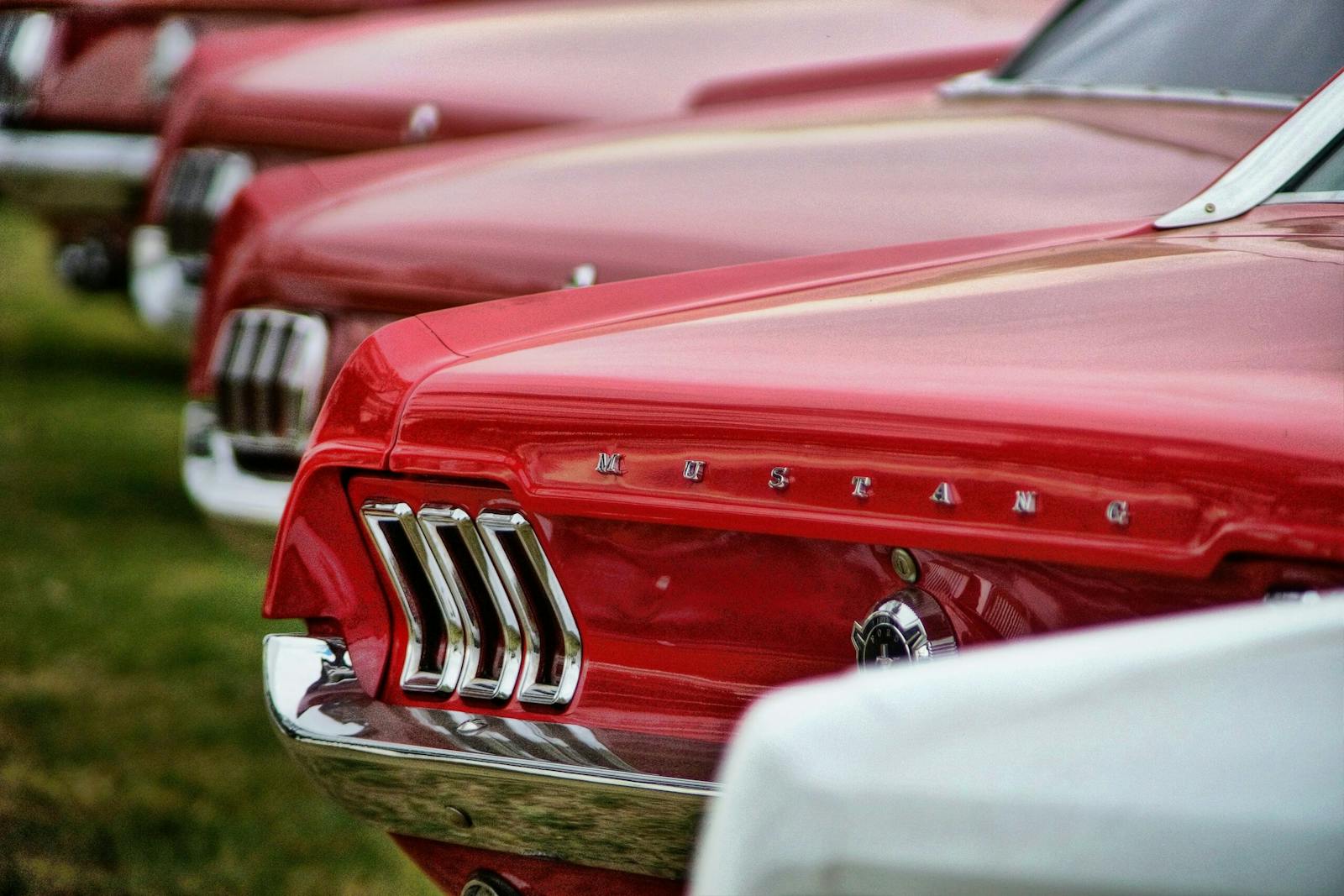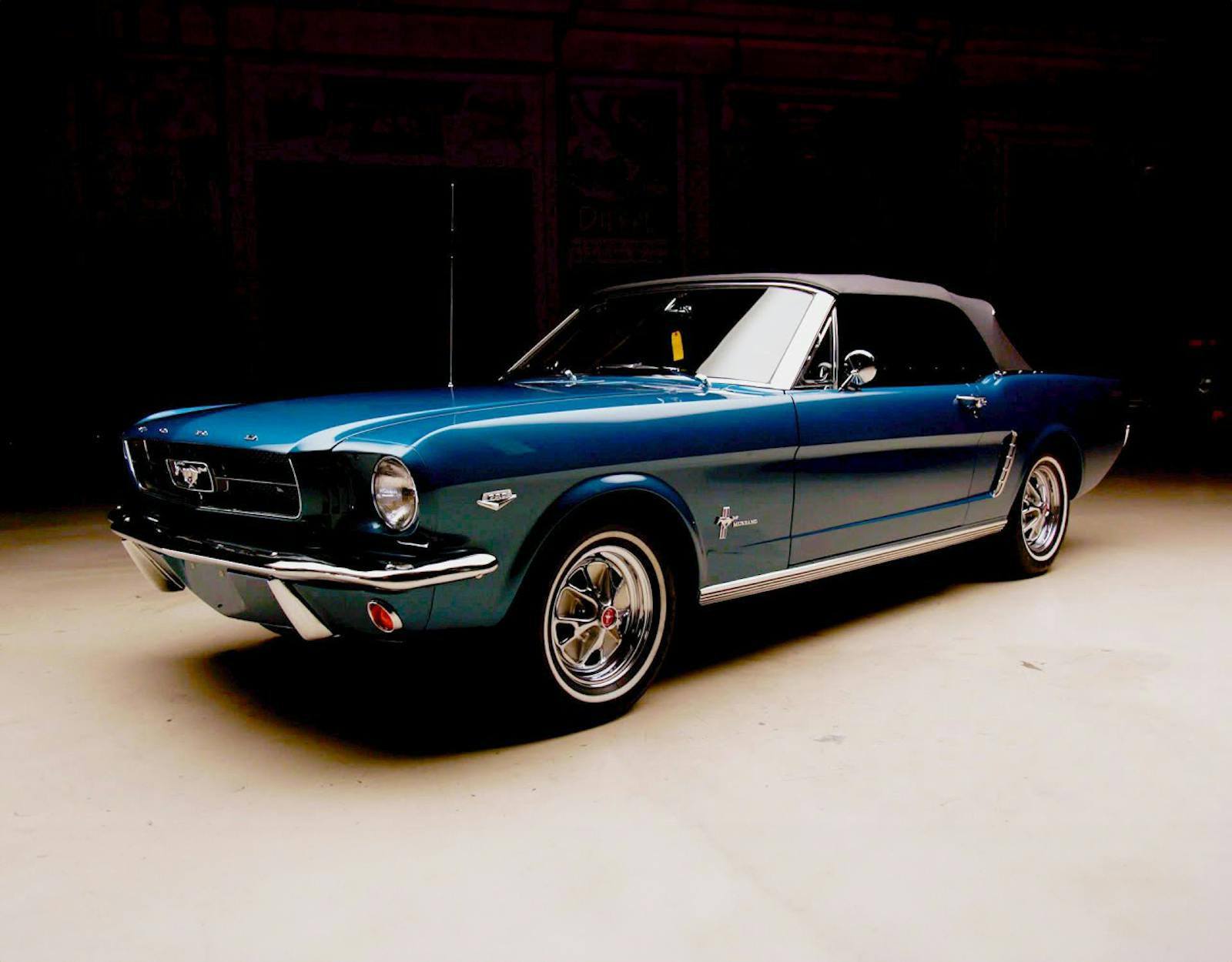Tri-Fives: The dreams of a ’50s hero live on
Want a better understanding of what’s driving collector car values? Sign up for the Hagerty Insider newsletter.
When he was a sophomore at St. Joe’s high school on Cleveland’s east side in 1973, my cousin, Tom Luzar, bought a ’56 Chevy. Well, he bought a significant portion of one, anyway.
“It was just a shell, really. It didn’t have an engine or interior,” he said. Over the course of the next two years, he built the car of his young dreams. Prepped for drag racing’s C/Gas class, Luzar and the ’56 held court at car shows throughout his high school years. “I took it to the Cleveland Autorama downtown at the convention center in ’75, ’76, and put a ‘for sale’ sign in the window when I took it there in ’77. Someone was interested, but wanted to see how it placed. After it took first in class, he bought the car.”
A Tri-Five—shorthand for ’55-’57 Chevys—no longer graced his driveway, but Luzar kept the memory of his ’56 close. In 2020, my cousin happened upon a gasser that looked almost exactly like the one he built, and he decided to rekindle those dreams. Though it didn’t turn out to be his old car, Luzar bought it and turned it into his COVID project.

Two and a half years later, Luzar’s 210 Sedan, the mid-level model slotted between the base 150 and the top-tier Bel Air, is nearly complete. This time around, he took a more streetable approach to his build: high-riding, drag-strip-ready front leaf springs made way for a more conventional setup, although ladder bars and QA1 coilover shocks in the rear make sure the car will still hook up like a proper gasser. A Chevy crate motor with some mild tweaks is backed up by a TH400 automatic transmission and a 3.70 Positraction rear end. “It’s not too much gear for the highway, and it’s still pretty fun from a dig,” added Luzar. The interior is more cruiser than race car, befitting a gearhead who’s now more intent on summer weekend use than optimizing weight for a specific NHRA class.
“For me, the Tri-Fives, particularly the ’55 and ’56 model years, are the grassroots drag racing car,” he said.
My cousin has a point. Tri-Five Chevys are still widely known in popular culture—they’re perhaps the quintessential 1950s American car—but their specific role in fueling car enthusiasm and the motorsports scene in America has arguably become under-appreciated as the decades pass. (Yes, Harrison Ford raced one in American Graffiti, but that movie came out—wait for it—fifty years ago.) These cars are an enthusiast’s canvas, successfully taking to customization, circle track racing, drag racing, or whatever their owners can think of.

That combination of adaptability and a design that’s so representative of the era helps explain their staying power and continued relevance in the car hobby, even as some cars from the 1950s fade. We frequently hear, and occasionally write about, the potential for a pivot in values for vehicles of certain eras as Baby Boomers begin to age out of the market. Of course, pantheon cars like 1950s–60s Ferraris or certain prewar brands like Bugatti are more insulated from demographic-influenced market movement, but the impact of this slow change in buyers remains a more open question for mass-market cars. Luckily for Luzar’s Chevy and those like it, interest among younger generations is not only strong, it’s growing.
The share of insurance quotes for Tri-Fives sought by boomers started to decline in 2021 and now stands at 46.6%, but the increased attention from younger generations is the real story. Share of Gen-X interest has increased nearly 20% since 2017, Millennial interest has doubled and, while still small, the share occupied by Gen-Z interest has nearly tripled in the same time period.
This widespread interest helps explain why the venerable Chevys have held on to their value and then some. We examined recent values for V-8-powered 210 Del Ray and Bel Air trims across the three-year model range. #1-condition concours-level cars are valued at $64,245, a 13% increase since 2017. Values for #2 (excellent) condition cars have remained steady, posting 1% growth in that same five year span. That slow, steady growth is what you’d expect and want to see in a mature segment, where collectors have for decades had a good sense of what the cars are worth. It also hints that the new, younger buyers are paying at least as much for their cars as the older generation—something we’ve noted to be true across the board with younger collectors.
On the other hand, driver-quality car values are down (-1% and a full -20% for #3 and #4 conditions, respectively) and can be had for between $20,000–$30,000. That’s a far cry from the days you could pick them up at a used car lot, but still relatively affordable for a collector car. Displacement matters, too: the 283-cubic inch V-8 commands a 34% premium over the 265 when both were available in 1957.
Given the breadth of the three trims along with various engine options, value differences from one Tri-five to another can constitute quite a spread. The above chart hits the upper-middle of the market, considering the 210 Del Ray and iconic Bel Air as equipped with V-8 options, but excluding the exotic-for-the-time Fuelie as well as the higher-performance dual-carburetor setup. Naturally, the Bel Airs, particularly the ’57—the one even non-enthusiasts seem to know all these decades later—fetch top dollar. In addition to the premium paid for condition, there’s clearly a value bump for the most popular, highest trim car. What that means, though, is that there’s plenty of opportunity to get in at a lower price point if you don’t mind a little less chrome or fewer options.
There are added bonuses to these cars having been popular from the get-go: yes, they’re old, but with high production numbers there are still more out there than many other models from the ’50s. Also, the Tri-Five aftermarket is strong, although Luzar noted that he ran into a few challenges during his build that suggest that might be changing slightly. There are also a lot of ’55-’57 Chevy resources out there—at this point, if you’re stumped while working on one, you’re probably not the first, and there’s likely a solution out there.
Regardless of which year you choose or whether you’re restoring to factory spec, building a period-correct gasser, or a creation of your own design, the Tri-Five will eagerly accommodate you. As for my cousin, he expects to have his ’56 on the road once the Northeast Ohio winter gives way to spring. “I’m an old-school car guy,” said Luzar. “That’s why I built the car the way I did—in keeping with how I remember working on cars as a teenager, but with a little comfort for cruising.” I can’t wait to meet up with him at the local shows.

Check out the Hagerty Media homepage so you don’t miss a single story, or better yet, bookmark it.



I’m a Boomer and I’ve owned around 10 tri-fives (only one ’57) over time. But I owned them back when they were 10-15 year-old cars, and most could be bought for far less than $500. I never owned a post car – all hardtops except for one ’55 4-door (the ’57 was a convertible). If you were a Chevy guy in the mid-to-late ’60s, a tri-five was likely what you had – or wanted to have. Then the muscle cars started to hit the market and people gravitated to them. When I see one these days (especially one like Mr. Luzar’s), it takes me back to the days when my time was spent living pretty much exactly what you see when you watch American Graffiti.
I’ll likely never get my hands on another one, but I’m happy they are still popular, as they are pure nostalgia to me and a lot of my pals.
I was out of the army when the ’55’s came out, kid with his dad’s new ’55 Chev was at the drag track, I saw pieces of his heads go thru’ his hood, oil on the track, those first V8’s had their problems. I opted for a ’53 Ford convert’ and a new girlfriend, never looked back. Friend had a ’56 tri-5, it rattled, seemed a little ‘junky’, I never did own one.
55-57 Chev cars were the right size, shoebox bodystyle (ala earlier Fords) and had modern suspension and drivetrain.
49-54 Chevs were similar size but had fat-fender (or vestiges of it) styling, archaic suspension, torque tube,etc..
58-64 (some of which I love) are big cars.
The next sweet spot is the GM A-bodies… which happen to be the same size as the 55-57, similar frame and suspension, and more refined versions of the small block (and big block…) V8.
Good aspects of this echoed down more decades (i.e., metric chassis 80s GM Midsize is most of the same notes again in a different style wrapper).
If GM had changed everything in 1958 so you couldn’t put the newer engines easily in 55 maybe this plays out a bit different. It’s a rather reasonable effort to make a 55 chev drive as well with all the comforts of at least a late 80s car. It’s a lot harder to do that to a 1951 Kaiser Manhattan (pretending all money being equal).
Doesn’t hurt that the 55 Chev is an all-time inspired design.
Bought a 55 Nomad major project around 1975. Never finished it, and sold it shortly after buying a nice, nearly road ready 57 convertible that we had for 2 or 3 years. Back then 20 year old Tri-Fives where just kind of cool “REALLY OLD” cars. Now have a 48 year old car that doesn’t seem to be as old as they did at the time.
Never was a Tri 5 fan but had a 57 TBird till I gave it to my son! We had 65 Impala 300 horse -327. We installed a mechanical Motorola echo chamber. Between Carzoro and San Antonio NM it was miles of nothing! After my wife came on from visiting her parents the next day we were going some where I said you were running more than 90 last night. She said how do you know -I said you turned off the echo chamber! She said you know it starts degrading above 90 so I turned off!
I built 2 56 chevy’s, one for my daughter to get tickets with and one for myself. Mine was a business coupe, no back seat, just a deck. I installed a 327 with an overdrive transmission which were still available at that time. tube headers, 2 1/2 out. It got 22 mpg. Driving past a dealers lot there was a C2 Corvette calling out to me. The dealer took my 56 for a trade in and we drove home in the C2 after we ran out of gas leaving the dealership.
Had a 56 Bel Aire hardtop back in 69. Tore out the 6 when the fiber timing gear wore out. Found a nice 327 in a junkyard and teamed it up with a Pontiac overdrive 3 speed trans. Had a lot of fun racing guys on the street.
Ah the good old days♥️
Hey Boys. Check out the 49thru 52 Chevys. I have a ’50 that I’ve turned into a really “old school” 50’s hot rod. It never fails to get a lot of Thumbs Up when I take the wife for a ride on Sundays for ice cream or a coffee.
I’m a Boomer. Had a lot of rare cars over the years. Best memories include the “tri-fives”. I noticed Dale’s comments about his ’56 business coupe. I did that with a ’55 business coupe. Loved the fact that Chevy’s design allowed dropping small block V8’s in without major modification. Biggest regret was passing up an opportunity to buy a ’56 Bel Air, 4-door hardtop with (get this) factory air and electric windows. I’d love to find one now and maybe give “pick-of-the-litter” on my collection to get it.
My first car was a used 55 Chev with 19,000 miles. After driving it for a couple years, started losing oil pressure so took it to my uncles shop for an overhaul. Parts didn’t fit, finally hauled the block to the parts house, and discovered that it had a Corvette engine!